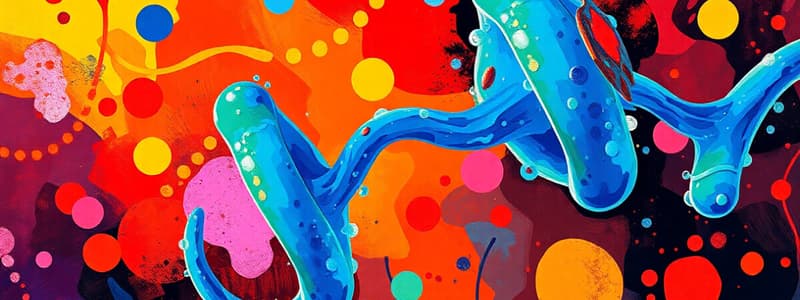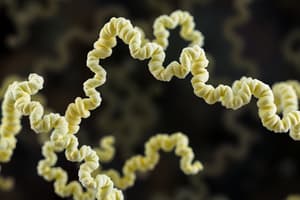Podcast
Questions and Answers
What role do enzymes play in biological processes?
What role do enzymes play in biological processes?
Enzymes act as biological catalysts that direct metabolic events, exhibit specificity toward substrates, and regulate metabolism.
How are proteins formed from amino acids?
How are proteins formed from amino acids?
Proteins are formed through the dehydration polymerization of amino acids, where each amino acid is linked by peptide bonds.
Why is the three-dimensional structure of proteins significant?
Why is the three-dimensional structure of proteins significant?
The three-dimensional structure of proteins is crucial because it determines their biological activity and functionality.
Explain the concept of protein denaturation.
Explain the concept of protein denaturation.
What are the classifications of carbohydrates?
What are the classifications of carbohydrates?
What distinguishes a disaccharide from a monosaccharide?
What distinguishes a disaccharide from a monosaccharide?
What is the significance of amino acid composition in proteins?
What is the significance of amino acid composition in proteins?
How do carbohydrates function in living organisms?
How do carbohydrates function in living organisms?
What is the primary function of ATP in cellular metabolism?
What is the primary function of ATP in cellular metabolism?
Describe the process of β-oxidation of fatty acids.
Describe the process of β-oxidation of fatty acids.
What is meant by the term 'free energy' in biochemical reactions?
What is meant by the term 'free energy' in biochemical reactions?
How does the electron transport chain contribute to ATP production?
How does the electron transport chain contribute to ATP production?
What role do uncouplers play in cellular respiration?
What role do uncouplers play in cellular respiration?
What is the significance of the Kreb's cycle in metabolism?
What is the significance of the Kreb's cycle in metabolism?
Identify and explain one respiratory poison and its mechanism of action.
Identify and explain one respiratory poison and its mechanism of action.
Explain the process of lipid digestion and absorption in the body.
Explain the process of lipid digestion and absorption in the body.
What is zymogen activation and provide an example?
What is zymogen activation and provide an example?
How does reversible covalent modification regulate enzyme activity?
How does reversible covalent modification regulate enzyme activity?
Define allosteric modulation and its effect on enzymatic activity.
Define allosteric modulation and its effect on enzymatic activity.
What are feedback inhibitors and how do they function in metabolic pathways?
What are feedback inhibitors and how do they function in metabolic pathways?
What distinguishes positive allosteric effectors from negative effectors?
What distinguishes positive allosteric effectors from negative effectors?
What role does the Vmax play in enzyme kinetics related to allosteric regulation?
What role does the Vmax play in enzyme kinetics related to allosteric regulation?
Explain the relationship between Km and enzyme activity.
Explain the relationship between Km and enzyme activity.
Why is feedback inhibition considered a common regulatory mechanism in biosynthetic pathways?
Why is feedback inhibition considered a common regulatory mechanism in biosynthetic pathways?
What type of reactions do Class I oxidoreductases catalyze, and provide an example?
What type of reactions do Class I oxidoreductases catalyze, and provide an example?
Define the function of Class II transferases and give an example reaction.
Define the function of Class II transferases and give an example reaction.
Describe the primary action of Class III hydrolases and provide a specific example.
Describe the primary action of Class III hydrolases and provide a specific example.
What distinguishes Class IV lyases from other enzyme classes, and provide an example?
What distinguishes Class IV lyases from other enzyme classes, and provide an example?
Explain the role of Class V isomerases and illustrate with an example.
Explain the role of Class V isomerases and illustrate with an example.
What reactions do Class VI ligases catalyze, and can you provide a reaction example?
What reactions do Class VI ligases catalyze, and can you provide a reaction example?
Identify the substrate and products in the reaction catalyzed by hexokinase.
Identify the substrate and products in the reaction catalyzed by hexokinase.
What types of bonds can Class III hydrolases act upon, and provide a general example?
What types of bonds can Class III hydrolases act upon, and provide a general example?
What is the significance of feedback regulation in biosynthetic pathways?
What is the significance of feedback regulation in biosynthetic pathways?
How are plasma enzymes classified according to their origin?
How are plasma enzymes classified according to their origin?
What causes an increase in plasma levels of intracellular enzymes?
What causes an increase in plasma levels of intracellular enzymes?
In what conditions might plasma lipase levels be low?
In what conditions might plasma lipase levels be low?
What is the role of α-amylase in the body?
What is the role of α-amylase in the body?
How are α-amylase levels used diagnostically?
How are α-amylase levels used diagnostically?
What can elevated trypsin levels in plasma indicate?
What can elevated trypsin levels in plasma indicate?
What can measurement of enzyme concentrations in plasma reveal?
What can measurement of enzyme concentrations in plasma reveal?
What specific glycosidic linkage does pancreatic amylase hydrolyze?
What specific glycosidic linkage does pancreatic amylase hydrolyze?
What are the products formed when lactose is hydrolyzed by lactase?
What are the products formed when lactose is hydrolyzed by lactase?
How does lactose intolerance affect adults who lack lactase?
How does lactose intolerance affect adults who lack lactase?
What is the pH range for maltase, and what reaction does it catalyze?
What is the pH range for maltase, and what reaction does it catalyze?
What products are formed from the hydrolysis of sucrose by sucrase?
What products are formed from the hydrolysis of sucrose by sucrase?
Explain the two mechanisms of carbohydrate absorption mentioned.
Explain the two mechanisms of carbohydrate absorption mentioned.
Why are monosaccharides the only carbohydrates that can be absorbed directly into the bloodstream?
Why are monosaccharides the only carbohydrates that can be absorbed directly into the bloodstream?
Which monosaccharide is absorbed faster, fructose or pentoses, and why?
Which monosaccharide is absorbed faster, fructose or pentoses, and why?
Flashcards
Catabolism of Fuel Molecules
Catabolism of Fuel Molecules
The process of breaking down fuel molecules to generate energy in the form of ATP. This energy is then used by the body for various biological processes.
What is free energy?
What is free energy?
A measure of the energy available to do work in a chemical reaction. A negative free energy change indicates a reaction that releases energy, while a positive free energy change indicates a reaction that requires energy.
Oxidation Reduction Reactions
Oxidation Reduction Reactions
Chemical reactions that involve the transfer of electrons between molecules. One molecule loses electrons (oxidation) and the other gains electrons (reduction).
What is Aerobic Energy Generation?
What is Aerobic Energy Generation?
Signup and view all the flashcards
What is the Krebs Cycle?
What is the Krebs Cycle?
Signup and view all the flashcards
What is Oxidative Phosphorylation?
What is Oxidative Phosphorylation?
Signup and view all the flashcards
What is Respiratory Control?
What is Respiratory Control?
Signup and view all the flashcards
What are Uncouplers?
What are Uncouplers?
Signup and view all the flashcards
Enzymes
Enzymes
Signup and view all the flashcards
Denaturation
Denaturation
Signup and view all the flashcards
Monosaccharide
Monosaccharide
Signup and view all the flashcards
Disaccharide
Disaccharide
Signup and view all the flashcards
Polysaccharide
Polysaccharide
Signup and view all the flashcards
Amino Acids
Amino Acids
Signup and view all the flashcards
Proteins
Proteins
Signup and view all the flashcards
Tertiary Structure
Tertiary Structure
Signup and view all the flashcards
What are Oxidoreductases?
What are Oxidoreductases?
Signup and view all the flashcards
What are Transferases?
What are Transferases?
Signup and view all the flashcards
What are Hydrolases?
What are Hydrolases?
Signup and view all the flashcards
What are Lyases?
What are Lyases?
Signup and view all the flashcards
What are Isomerases?
What are Isomerases?
Signup and view all the flashcards
What are Ligases or Synthetases?
What are Ligases or Synthetases?
Signup and view all the flashcards
What is the Enzyme Commission (EC) Number System?
What is the Enzyme Commission (EC) Number System?
Signup and view all the flashcards
Why is enzyme classification important?
Why is enzyme classification important?
Signup and view all the flashcards
Lactase
Lactase
Signup and view all the flashcards
Lactose Intolerance
Lactose Intolerance
Signup and view all the flashcards
Absorption of Carbohydrates
Absorption of Carbohydrates
Signup and view all the flashcards
Simple Diffusion
Simple Diffusion
Signup and view all the flashcards
Active Transport
Active Transport
Signup and view all the flashcards
Pancreatic amylase
Pancreatic amylase
Signup and view all the flashcards
Maltase
Maltase
Signup and view all the flashcards
Sucrase
Sucrase
Signup and view all the flashcards
What are proenzymes or zymogens?
What are proenzymes or zymogens?
Signup and view all the flashcards
What is allosteric regulation?
What is allosteric regulation?
Signup and view all the flashcards
What are allosteric effectors?
What are allosteric effectors?
Signup and view all the flashcards
What is feedback inhibition?
What is feedback inhibition?
Signup and view all the flashcards
How does feedback inhibition work?
How does feedback inhibition work?
Signup and view all the flashcards
What is reversible covalent modification?
What is reversible covalent modification?
Signup and view all the flashcards
What is zymogen activation?
What is zymogen activation?
Signup and view all the flashcards
What is zymogen activation?
What is zymogen activation?
Signup and view all the flashcards
Intracellular Enzymes
Intracellular Enzymes
Signup and view all the flashcards
Plasma Enzymes
Plasma Enzymes
Signup and view all the flashcards
Enzyme Activity & Tissue Damage
Enzyme Activity & Tissue Damage
Signup and view all the flashcards
Enzymes as Diagnostic Tools
Enzymes as Diagnostic Tools
Signup and view all the flashcards
Lipase: The Fat Breaker
Lipase: The Fat Breaker
Signup and view all the flashcards
α-Amylase: The Starch Breaker
α-Amylase: The Starch Breaker
Signup and view all the flashcards
Trypsin: The Protein Breaker
Trypsin: The Protein Breaker
Signup and view all the flashcards
Enzymes and Disease Monitoring
Enzymes and Disease Monitoring
Signup and view all the flashcards
Study Notes
Lecture Notes
- Medical Biochemistry lecture notes for health science students were produced in collaboration with the Ethiopia Public Health Training Initiative, The Carter Center, The Ethiopia Ministry of Health, and the Ethiopia Ministry of Education in 2004.
- The authors are Solomon Adugna, Lakshmi Ahuja Mekonnen Alemu, Tsehayneh Kelemu, Henok Tekola, Belayhun Kibret, and Solomon Genet.
- The notes cover topics including Enzymes, Carbohydrate Metabolism, Lipid Metabolism, Amino Acids & Proteins, Vitamins & Coenzymes, Mineral Metabolism, Hormones, and Molecular Genetics.
- The notes are intended for educational use only by practicing health care workers or students and faculty in a health care field.
Acknowledgements
- The authors thank the Carter Center (EPHTI) for its financial and logistical support.
- They also thank the administrations of Gondar University, Debub University, and Jimma University for their cooperation.
- The authors express gratitude to Ato Akililu Mulugeta and Abdel-Aziz Fatouh Mohammed (Ph.D) and Daniel Seifu for their professional editing and helpful feedback.
Table of Contents
- The table of contents lists the various topics covered in the lecture notes, including relevant subtitles and page numbers.
Studying That Suits You
Use AI to generate personalized quizzes and flashcards to suit your learning preferences.




